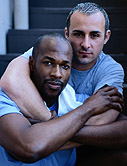- Skip Storing This Everyday Product in the Fridge Door
- Green Tea + B3 Pairing May Boost Brain Health
- Navigating Your Midlife Crisis: Embracing New Possibilities
- City Raccoons Showing Signs of Domestication
- Mapping the Exposome: Science Broadens Focus to Environmental Disease Triggers
- One Week Less on Social Media Linked to Better Mental Health
- Your Brain Changes in Stages as You Age, Study Finds
- Some Suicide Victims Show No Typical Warning Signs, Study Finds
- ByHeart Formula Faces Lawsuits After Babies Sickened With Botulism
- Switch to Vegan Diet Could Cut Your Greenhouse Gas Emissions in Half
Half of HIV-Positive Gay Men in U.S. Aren’t Getting Proper Treatment


Even though gay and bisexual men make up the majority of Americans infected with HIV, half aren’t receiving ongoing care or getting the virus-suppressing drugs they need to stay healthy, a new report finds.
The study, from the U.S. Centers for Disease Control and Prevention (CDC), looked at 2010 data on more than 400,000 male gay and bisexual Americans who were infected with HIV, the virus that causes AIDS.
The research shows that while 77.5 percent did initially get HIV medical care within three months of their diagnosis, only about 51 percent continued getting care on an ongoing basis.
Experts note that HIV infection can be manageable if powerful antiviral drugs are taken on a regular basis. But the CDC report finds that less than half of HIV-positive gay or bisexual men were prescribed such drugs, and only 42 percent achieved healthy “viral suppression.”
Why are so many infected men not getting proper treatment? The CDC researchers said many factors could be at play.
“Lack of health insurance, stigma and discrimination might influence whether [gay and bisexual men] access medical care,” they wrote. Gaining access to care soon after diagnosis is crucial to whether or not a patient continues to get virus-suppressing medications, the team added.
Younger men and minority males appear to be at highest risk of not getting the HIV-related treatment they need, said the team led by CDC researcher Sonia Singh.
For example, while 84 percent of men aged 45 to 54 who were newly diagnosed with HIV got linked to medical care, that proportion dropped to 71 percent for males ages 13 to 24. A similar “age gap” was seen in statistics relating to ongoing retention in HIV medical care, the CDC study found.
The gap widened when it came to men taking HIV-suppressing medications. While nearly 68 percent of infected gay or bisexual men age 55 or older were on the drugs, that number fell to just 30.5 percent for those aged 18 to 24, the study found.
Minorities were more likely to miss out on needed care compared to white patients, the CDC added. While about 83 percent of white gay or bisexual men infected with HIV got linked to care soon after their diagnosis, the rate for blacks fell to about 72 percent.
All of these numbers fall short of targets from the CDC’s National HIV/AIDS Strategy, which aims to have 80 percent of infected gay and bisexual men retained in ongoing medical care by 2015.
According to the CDC, gay or bisexual males make up 2 percent of the U.S. population but comprise 52 percent of Americans infected with HIV. Many are unaware they are infected.
The CDC team noted that, “in 2011, the National HIV Behavioral Surveillance System in 20 cities found that only 49 percent of [gay and bisexual men] aged 18-24 years who tested positive were aware of their HIV infection.” Young black or Hispanic men are at much higher risk of not knowing their HIV status, the CDC said.
According to experts, early detection is crucial to getting newly diagnosed patients into care and to curb the spread of HIV.
“Persons who are aware of their HIV-positive status are less likely to engage in risky behaviors that increase the probability of transmitting HIV to sex partners,” Singh’s team noted. Knowing your infection status can also help people “enter into care and treatment earlier, further improving health outcomes,” they added.
To that end, they advise that all sexually active but currently HIV-negative gay and bisexual men get an HIV test at least annually, and preferably every three to six months.
More outreach could help boost treatment levels, as well. The findings from the new report “highlight the need for continued expansion of prevention, care and treatment efforts,” particularly for younger and minority gay and bisexual men, the authors said.
The study is published in the Sept. 26 issue of the CDC journal Morbidity and Mortality Weekly Report.
More information
There’s more on HIV and AIDS at AIDS.gov.
Source: HealthDay
Copyright © 2025 HealthDay. All rights reserved.










